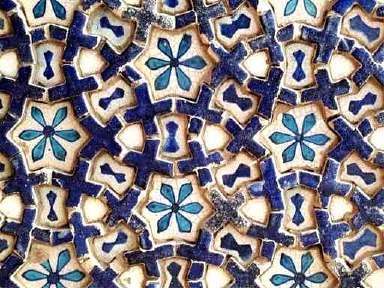 In the past we have covered the Gateways of Multan and the Saints and Shrines of Multan. Today we have brought another topic for you and that is the famous blue tile work (kashi gari) of Multan.
In the past we have covered the Gateways of Multan and the Saints and Shrines of Multan. Today we have brought another topic for you and that is the famous blue tile work (kashi gari) of Multan.
The history of Multani arts and crafts also goes back to medieval period. Kashi work, glazing and hand painting of ceramic products is an important art for which Multan is famous the would over. The use of foliage branches and leaves of trees and superb richness of colours (mainly blue) in Kashi work is an evidence of Persian influence. As Persian arts themselves have been under Chinese (Mongol) influence, therefore some historians are of the view that Kashi work had originally come from Kashghar, China. Over a period of centuries Multani Kashi work has matured and developed a unique and distinctive style of its own.
The art has survived for centuries through generations as its trade secrets like composition of colours were zealously guarded by a handful of artist and their families. Artists like Ustad Allah Wasaya and others have left lasting work in the field and their work ahs lent an immortality to the art.
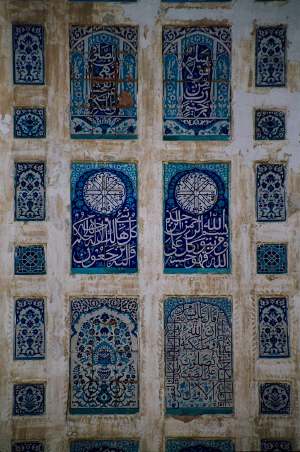 In 1853, during a limited excavation on Qillah Kohna Qasim Bagh, Alexander Cunningham found glazed tiles made in Multan in about 900 AD. These tiles had been used in the mosque built by Muhammad Bin Qasim on his arrival in Multan. The highest quality Multani tiles have been used in shrines, mosques and other important buildings including house ever since. The shrines of Shah Yousaf Gardezi (1153), Shah Rukne Alam, Ali Akbar, mosque Nawaban, Shrines of Uchh Sharif in Cholistan and Talpur tombs in Sindh are classic examples of tile work. Kashi work on the walls of shrine of Hazrat Haqani, Sawi Mosque, Shrines of Shah Abdul Latif Bhittai, Eidgah Multan and Lahore museum is very distinctive and of a fine quality. Lately Akhtar Abbas Bharwana (ex minister Punjab) has used the tiles from Multan at his house in Jhang. A contemporary artist Ustad Muhammad Alam has executed Kashi work in the house of late actor Sultan Rahi in Lahore.
In 1853, during a limited excavation on Qillah Kohna Qasim Bagh, Alexander Cunningham found glazed tiles made in Multan in about 900 AD. These tiles had been used in the mosque built by Muhammad Bin Qasim on his arrival in Multan. The highest quality Multani tiles have been used in shrines, mosques and other important buildings including house ever since. The shrines of Shah Yousaf Gardezi (1153), Shah Rukne Alam, Ali Akbar, mosque Nawaban, Shrines of Uchh Sharif in Cholistan and Talpur tombs in Sindh are classic examples of tile work. Kashi work on the walls of shrine of Hazrat Haqani, Sawi Mosque, Shrines of Shah Abdul Latif Bhittai, Eidgah Multan and Lahore museum is very distinctive and of a fine quality. Lately Akhtar Abbas Bharwana (ex minister Punjab) has used the tiles from Multan at his house in Jhang. A contemporary artist Ustad Muhammad Alam has executed Kashi work in the house of late actor Sultan Rahi in Lahore.
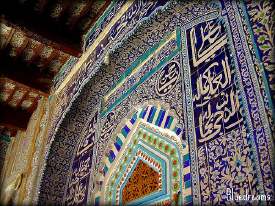 Blue pottery of Multan is at display in prestigious president’s house, prime ministers secretariat, culture missions of Pakistan in different countries and British Museum London. Foreign tourists and private collectors love to buy vases vessels planters, cookie jars and table lamps with hand painted in designs like China Kashi, Special Kashi and Bamboo Shoot. World Bank team has also visited the Institute and shown keen interest in the conservation and development of the art.
Blue pottery of Multan is at display in prestigious president’s house, prime ministers secretariat, culture missions of Pakistan in different countries and British Museum London. Foreign tourists and private collectors love to buy vases vessels planters, cookie jars and table lamps with hand painted in designs like China Kashi, Special Kashi and Bamboo Shoot. World Bank team has also visited the Institute and shown keen interest in the conservation and development of the art.
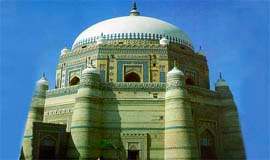 The process of making blue pottery and tiles has undergone many changes with the development in technology. Gas furnaces with controllable and uniform temperature are being used for biscuit firings and glazing instead of wood and dung cake fire. Clay is being procured from Manshera (NWFP), Tharparker (Sindh) and Gujrat (Punjab) instead of local red clay.
The process of making blue pottery and tiles has undergone many changes with the development in technology. Gas furnaces with controllable and uniform temperature are being used for biscuit firings and glazing instead of wood and dung cake fire. Clay is being procured from Manshera (NWFP), Tharparker (Sindh) and Gujrat (Punjab) instead of local red clay.
“Baking of raw material as per the formula, grinding, kneading, filtration, moulding, biscuit firing at the temperature of 800-850 degree centigrade, Kashi work and glazing at the temperature of 1200 centigrade are all necessary steps in the process,”
explained one young artist Muhammad Irfan wile showing everything being done at his concern by 20 ceramists and 15 Kashi artist and their students.
“The special blue colour prepared from cobalt oxide and copper oxide is a special technique and distinctive feature of the Kashi work,”
he says. The art has evolved into a far more sophisticated process today.
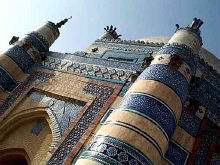 Among the various arts that are practiced in Pakistan, Multani Kashi work has attained a higher state of refinement. There is always a room to bring into the art new innovations, endow it with fresh spirit and set the science as its guide. Assistance can be sought from international agencies like UNESCO and the World Bank. The range of possibilities in the field of ceramics is very vast. The whole world can be the market for Blue Pottery from Multan.
Among the various arts that are practiced in Pakistan, Multani Kashi work has attained a higher state of refinement. There is always a room to bring into the art new innovations, endow it with fresh spirit and set the science as its guide. Assistance can be sought from international agencies like UNESCO and the World Bank. The range of possibilities in the field of ceramics is very vast. The whole world can be the market for Blue Pottery from Multan.




















































59xhkt
Die Rolex Cosmograph Daytona ist ein Meisterwerk der chronographischen Präzision , kombiniert elegante Linien mit höchster Funktionalität durch seine Tachymeterskala .
Verfügbar in Keramik-Editionen überzeugt die Uhr durch das ausgewogene Zifferblatt und hochwertige Materialien , die passionierte Sammler begeistern .
Dank einer Batterie von 72 Stunden eignet sie sich für den Alltag und behält stets ihre Genauigkeit unter extremsten Umständen.
Rolex Cosmograph Daytona 116500LN armbanduhren
Die ikonischen Unterzifferblätter in Schwarz unterstreichen den sportiven Charakter , während die kratzfeste Saphirglase Zuverlässigkeit sicherstellen.
Über Jahrzehnte hinweg bleibt sie ein Maßstab der Branche, geschätzt für ihre Seltenheit bei Uhrenliebhabern weltweit.
Ob im Rennsport inspiriert – die Cosmograph Daytona verkörpert Tradition und etabliert sich als zeitloser Klassiker für wahre Kenner.
Shimmering liquid textiles dominate 2025’s fashion landscape, blending futuristic elegance with eco-conscious craftsmanship for runway-ready statements .
Gender-fluid silhouettes break traditional boundaries , featuring modular designs that adapt to personal style across casual occasions.
Algorithm-generated prints merge digital artistry , creating one-of-a-kind textures that react to body heat for personalized expression.
https://onetable.world/read-blog/70918
Circular fashion techniques set new standards, with biodegradable textiles celebrating resourcefulness without compromising bold design elements.
Light-refracting details add futuristic flair, from nano-embroidered handbags to self-cleaning fabrics designed for avant-garde experimentation.
Vintage revival meets techwear defines the year, as 2000s logomania reinterpret archives through climate-responsive materials for forward-thinking style.
Shimmering liquid textiles dominate 2025’s fashion landscape, blending futuristic elegance with eco-conscious craftsmanship for everyday wearable art.
Unisex tailoring break traditional boundaries , featuring asymmetrical cuts that adapt to personal style across formal occasions.
AI-curated patterns merge digital artistry , creating hypnotic color gradients that shift in sunlight for personalized expression.
https://elovebook.com/read-blog/540
Zero-waste construction set new standards, with upcycled materials reducing environmental impact without compromising luxurious finishes .
Light-refracting details add futuristic flair, from solar-powered jewelry to self-cleaning fabrics designed for avant-garde experimentation.
Vintage revival meets techwear defines the year, as 90s grunge textures reinterpret archives through climate-responsive materials for forward-thinking style.